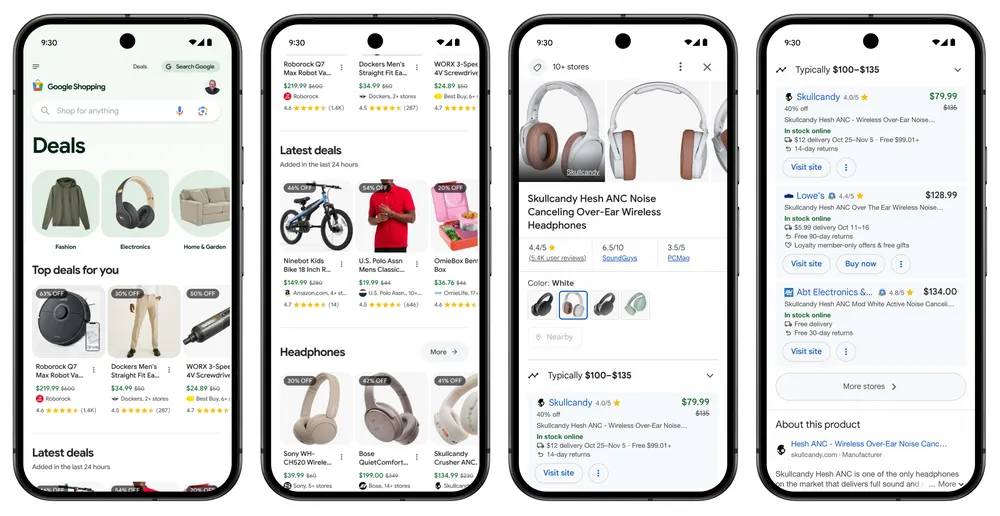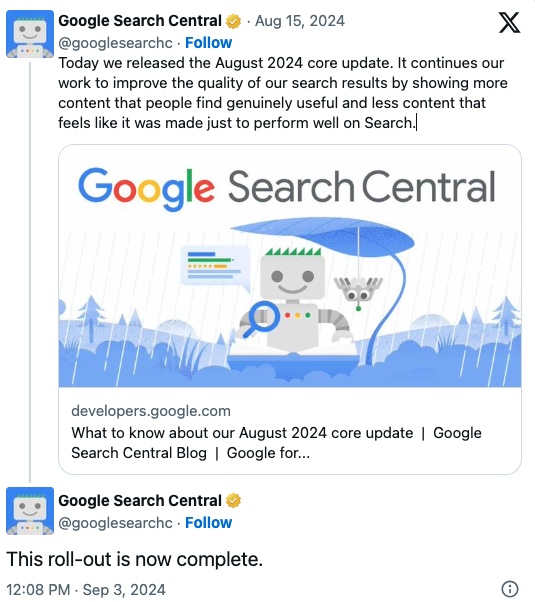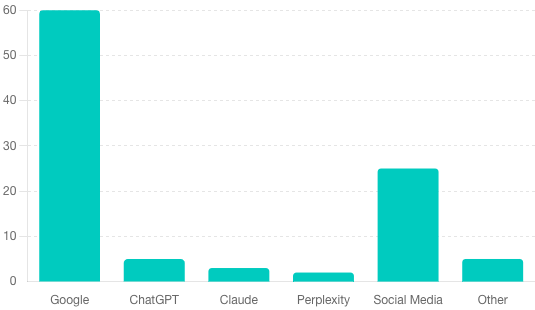Google’s online shopping was revamped in the United States in the last several week. Google has unveiled a game-changing transformation of its Shopping sites, introducing a revolutionary AI-driven experience set to redefine the e-commerce landscape.
This revamp pairs Google’s extensive Shopping Graph—boasting 45 billion product listings—with its powerful Gemini models, setting a new standard for personalization and convenience in e-commerce. As of today, U.S. users will begin to experience the convenience of this new AI-driven Shopping platform. This platform will simplify and streamline how people research, compare, and purchase products.
For example, the new AI-powered Shopping experience can assist consumers in finding the ideal men’s winter jacket by making tailored recommendations based on specific requirements, such as climatic considerations for the Pacific Northwest. The new Google shopping experience will be fully implemented across the United States in the coming weeks, providing everyone with a more convenient shopping experience. The GSE claims to simplify and streamline how people research, compare, and purchase product experiences for everyone.
GSE is set to change how consumers look for, compare, and buy products, simplifying and streamlining the entire experience. For instance, their new AI-driven shopping feature can help shoppers find the perfect men’s winter jacket by offering personalized suggestions based on factors like the specific climate in the Pacific Northwest.
The new Google shopping experience will be fully implemented across the United States in the coming weeks, providing everyone with a more convenient buying experience.
AI is at the core of the new Google shopping experience. Google shopping sites no longer only provide consumers with product listings.
Now, it provides AI-generated briefings to help people navigate their Google shopping experience. These briefs highlight essential variables before purchasing a product, allowing customers to interact with the platforms more successfully. However, it goes beyond simply recommending products.
Google Shopping has increased classification, showing products in a more structured format, making it easier for customers to navigate their alternatives.
Furthermore, adding dynamic filters allows users to narrow their Google shopping search by size, availability, and geographic proximity, resulting in more relevant results and less choice fatigue. For example, users may instantly find a men’s winter jacket by filtering by size, availability, and local weather conditions. Users can submit comments on AI-generated briefs to help Google enhance its shopping experience.
The example below shows a mobile version of the new Google shopping experience, with users searching for “tea kettle for matcha.”
Similarly, the new desktop Google Shopping experience has received a significant upgrade when using the exact search for “tea kettle for matcha.”
Integrating AR (augmented reality) and AI shopping tools is even more exciting. Users can try on clothing or accessories via Virtual reality, which can help speed up the purchase decision-making process.

Google Shopping’s AI Technology
Google Shopping’s AI technology is revolutionizing the online shopping experience. By leveraging advanced artificial intelligence, Google Shopping can offer users highly personalized product recommendations that cater to their unique preferences and needs. This means the platform can suggest products that are most relevant to you, whether you’re searching for a specific item or browsing.
One of the standout features powered by AI is the dynamic filters. Such filters allow users to refine their search based on criteria such as price, brand, and specific product features. This makes it incredibly easy to narrow down options and find what you’re looking for without sifting through endless listings.
Additionally, Google Shopping’s AI technology enhances the shopping experience with virtual try-ons. This feature allows users to see how clothing or accessories will look on them before making a purchase, adding a layer of confidence to their buying decisions.
Moreover, the AI-driven platform ensures that users always get the best prices and deals. By constantly evaluating market trends and prices, Google Shopping can highlight the most cost-effective solutions, making it easier for customers to locate amazing offers. By continuously analyzing market trends and prices, Google Shopping can highlight the most cost-effective options, making it easier for shoppers to find great deals.
This AI technology opens up new avenues for brands to connect directly with shoppers. Through assistive experiences like AI shopping, brands can engage with their audience more meaningfully, providing tailored recommendations and offers that resonate with individual shoppers.
Personalized Shopping Tailored to Each User
A new personalized homepage feed is another significant revamp of the Google Shopping experience.
Users will now start to see a compilation of shoppable products and videos based on their shopping behavior and preferences.
The platform aims to inspire consumers, not just help them buy. For example, AI-generated briefs can assist users in finding the most suitable men’s winter jackets based on their preferences and location.
The new Shopping platforms also allow users to resume where they left off in their search, making it seamless to continue their decision-making process without starting from scratch.
You can quickly revisit saved products, deals, and categories, creating a more continuous and connected shopping journey.
The example below shows the new personalized Shopping feed on a mobile device. It showcases individual products, deals, video content, and more.
Credit: Google, October 2024
Users who prefer a more personalized shopping experience can easily manage their preferences through their Shopping settings. Google allows users to turn off or customize the extent of personalization, giving them full control over their shopping journey and ensuring they feel empowered.
Enhanced Product Discovery with Dynamic Filters
Google Shopping’s dynamic filters are a game-changer for product discovery, empowering users to narrow their search results quickly. This efficiency makes the online shopping experience more time-efficient and enjoyable. Whether you’re looking for a specific brand, price range, or product features, dynamic filters make finding what you need simple and quick.
AI allows these filters to learn and adapt to user behavior over time. This means that the more you use Google Shopping, the more accurate and relevant your search results become. For instance, if you frequently search for eco-friendly products, the dynamic filters will prioritize these options in future searches.
The ability to search by various criteria such as price, brand, and product features ensures that users can quickly zero in on the perfect product. This saves time and reduces the frustration of wading through irrelevant results. For example, suppose you’re searching for a men’s winter jacket. In that case, you can filter results by size, material, and even specific features like waterproofing or insulation, ensuring you find the best match for your needs.
Dynamic filters also enhance the shopping experience by providing a more personalized and streamlined journey. By delivering hyper-relevant results, these filters help reduce decision fatigue, making it easier for users to make informed purchasing decisions.
In summary, Google Shopping’s dynamic filters significantly improve product discovery, making the online shopping experience more tailored and user-friendly. With these advanced tools, finding the perfect product has never been easier.
Finding the Best Prices Just Got Easier
The new Shopping experience features price comparison tools, price insights, and tracking options that allow users to monitor price fluctuations over time through the Shopping Tab on Google Search.
One standout feature is the personalized deals page, where users can browse customized deals based on their shopping behavior and interests.
By clicking the “Deals” tab, shoppers can instantly find the best offers tailored to them.
The examples below show the new Deals experience on a mobile device, showcasing items like:
-
-
- Carousel product categories
- Top deals
- Latest deals
- Regular product listing ads (PLAs)
- And more.
-
Expanding Reach with Merchant Center
Expanding your reach with Merchant Center can help you tap into the vast online shopping market. By creating a Merchant Center account, you can list your products on Google Shopping, making it easier for customers to find and purchase from your store. With Merchant Center, you can manage your product listings, track your performance, and optimize your campaigns for better results.
By using Merchant Center, you can increase your online visibility, drive more traffic to your website, and ultimately boost your sales. Additionally, Merchant Center provides valuable insights and analytics to help you understand your customers’ behavior and preferences, allowing you to make data-driven decisions to improve your online shopping experience.
Boosting Sales and Conversions
Boosting sales and conversions is a top priority for any online retailer. With Google AI-powered features, you can optimize your product listings to increase conversions and drive more sales. Dynamic filters can help customers quickly find what they’re looking for, and virtual try-ons can provide an immersive shopping experience that simulates the in-store experience.
Personalized deals and deal-finding tools can also help you attract price-conscious customers and increase conversions. By offering the best prices and providing a seamless shopping experience, you can build trust with your customers and encourage them to purchase. With Google Analytics and insights, you can track your performance and make data-driven decisions to optimize your campaigns and boost sales.
Improved Mobile Experience
With most online shoppers using mobile devices to browse and purchase products, providing an improved mobile experience is crucial for online retailers. Google Shopping is a mobile-friendly design, and features can help you provide a seamless shopping experience for your customers, regardless of the device they use.
By optimizing your product listings for mobile devices, you can increase your online visibility, drive more traffic to your website, and ultimately boost your sales. Additionally, Google Shopping’s mobile-friendly features, such as virtual try-ons and personalized deals, can help you provide an immersive shopping experience that simulates the in-store experience.
Benefits for Businesses
Google Shopping’s transformation offers numerous benefits for businesses, making it an essential tool for enhancing their online presence and driving sales. By integrating advanced AI-powered features, companies can significantly increase their online visibility and reach a wider audience.
Dynamic filters and AI-generated briefs play a crucial role in improving product discovery. These tools help users quickly find the most relevant products, allowing businesses to showcase their offerings more effectively. By presenting products in a more organized and accessible manner, companies can ensure that their products stand out in a crowded marketplace.
Another significant advantage is the enhanced customer experience of personalized deals and virtual try-ons. These features create a more engaging and interactive shopping experience, increasing customer satisfaction and loyalty. Shoppers can now virtually try on clothing or accessories, making their purchase decisions more accessible and confident.
Google Shopping’s deal-finding tools and price comparison features enable businesses to offer competitive pricing, helping them stay ahead of the competition. Companies can attract price-conscious customers and increase conversions by providing users with the best prices and personalized deals.
The new Google Shopping experience allows businesses to provide users with the most relevant products and information, driving sales and boosting conversions. By leveraging these innovative tools, companies can enhance their online shopping experience and succeed tremendously in the competitive e-commerce landscape.
Optimizing Product Listings for Google Shopping
Businesses must optimize their product listings effectively. Here are some key strategies to consider:
-
-
- Use High-Quality Product Images: High-quality images are essential for showcasing products in the best light. Clear, detailed images increase the chances of users clicking on the listing and making a purchase.
- Write Detailed and Accurate Product Descriptions: Accurate and detailed product descriptions help users understand the product features and benefits. This information is crucial for increasing the chances of conversion, as it gives users the confidence they need to purchase.
- Set Competitive Prices: It is vital to monitor and adjust prices regularly. Google Shopping’s deal-finding tools can help businesses identify the best pricing strategies to attract more customers.
- Utilize Dynamic Filters: Dynamic filters allow users to narrow their search results based on specific criteria. By using these filters, businesses can ensure that their products are showcased to the right audience, increasing the likelihood of conversion.
-
- For example, users can find a men’s winter jacket by size, material, and specific features like waterproofing or insulation.
-
- Provide Virtual Try-Ons: Virtual try-ons offer an immersive shopping experience, allowing users to visualize how products will look on them. This feature increases user engagement and conversion rates by simulating the in-store experience.
- Offer Personalized Deals: Personalized deals help businesses stand out from the competition. By tailoring offers to individual users based on their shopping behavior, companies can increase the chances of conversion and drive sales.
- Use AI-Generated Briefs: AI-generated briefs provide users with the most relevant information about a product. These briefs guide users through their shopping journey, increasing the chances of conversion and driving sales.
-
By optimizing product listings and utilizing Google Shopping’s new features, businesses can improve their online shopping experience, increase conversions, and drive sales. Leveraging these tools will help companies stay ahead in the competitive e-commerce landscape and provide a seamless shopping experience for their customers.
What This Means For Marketers
Google’s revamped Shopping platform is not just a game-changer for consumers—it’s also poised to impact the marketing landscape significantly. Acting as a powerful search engine facilitates product discovery and price comparison, enhancing the overall shopping experience. Here are a few impacts that the new experience may have on marketers.
#1: Product Discovery Is Now AI-Driven
Thanks to AI-generated product briefs, marketers now have an unparalleled opportunity to appear in highly personalized search engine results.
This level of detail allows Business to be more relevant at the research stage of a shopper’s journey, making it crucial for marketers to ensure their product data is optimized for Google’s search engine AI.
Brands that provide clear, concise product descriptions, high-quality images, and accurate attributes in their product feeds likely benefit from improved visibility.
#2: Enhanced Engagement with AR and Virtual Try-Ons
For fashion, beauty, and other visually driven categories, the inclusion of AR-based virtual try-ons represents a breakthrough in product showcase technology.
Marketers can leverage these tools to create more interactive and engaging shopping experiences, which can give potential buyers the confidence they need to complete a purchase.
As Google continues to develop these capabilities, brands should keep their product images top-of-mind and how users may interact with them when trying to make a purchase decision.
#3: Personalized Marketing Opportunities
The new personalized homepage and tailored deal feeds offer marketers a fresh way to reach their target audience.
With consumers now receiving highly curated shopping experiences, brands focusing on personalization in their campaigns will have a better chance of reaching shoppers with the right product at the right time.
#4: Price Transparency is Key
With price comparison and deal-finding tools baked into the new Shopping experience, marketers should focus on price competitiveness and transparency.
Consumers are more informed than ever, and with the ability to track and compare prices, local markets that offer clear value propositions will stand out.
Marketing strategies should emphasize quality and the best value for money, aligning with the price-conscious behavior this new Shopping model encourages.
#5: Experimentation and Feedback
Given that the AI-generated briefs are still experimental, marketers have the unique opportunity to shape this feature.
By encouraging customers to provide feedback and adjusting their product listings accordingly, commerce can play an active role in improving the AI’s accuracy and relevance.
This two-way interaction between marketers, consumers, and Google’s AI could eventually lead to more fine-tuned product recommendations and higher conversion rates.
The Future of E-commerce
The future of e-commerce is rapidly evolving, with AI-powered features and personalized shopping experiences becoming the norm. With Google Shopping’s AI-powered features, you can stay ahead of the curve and provide a seamless shopping experience that meets your customers’ evolving needs.
As the online shopping market continues to grow, it’s essential to stay ahead of the curve and provide a seamless shopping experience that meets the evolving needs of your customers. With Google Shopping’s AI-powered features and personalized shopping experiences, you can drive more traffic to your website, boost sales, and stay ahead of the competition.
Summary
Google’s reinvention of its Shopping platform marks a new era for online shopping—one that is faster, more personalized, and smarter, thanks to AI.
For marketers, this presents a host of opportunities to engage with customers more meaningfully, from optimized product listings to dynamic, immersive experiences like virtual try-ons.
As this new AI-powered Google Shopping continues to roll out across the U.S., marketers need to be ready to adapt and leverage these innovative tools to drive brand awareness and conversion.
The new shopping experience officially rolled out in the United States today and will continue to roll out over the coming weeks to more users.











